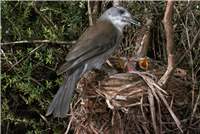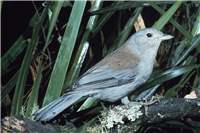Family
Orthonychidae
Genus
Colluricincla
Species
harmonica
Threats/Control Methods - Regional
The Grey Strike-thrush is dependant on the rich biodiversity of Canberra surrounding forests for food and shelter throughout most of the year. Many of these forests are not surviving well due to urban development and introduced species. In the ACT, it is possible that as little as 3-4% of the original extent of the Yellow Box/Red Gum Grassy Woodland remains in something like its natural state. Worse still, the adjoining NSW woodlands only remain at 0.01% of their original extent.
Threats/Control Methods - Local
Within the suburbs, birds are rarely seen, due to a lack of natural food availability and threats from domestic pets.
Local/Urban Actions
It is important that residents do not remove fallen timber and leaf litter from local nature reserves, as this is an important foraging resource for this species.
Common Names
Grey Shrike-thrush, Harmonica Bird, Grey Thrush, Harmonious Shrike-thrush, Whistling Strike-thrush
Distinguishing Features
This medium sized bird of 22-25cm has a slender body shape with a fairly strong beak and a long tail. It has grey plumage except for a patch of olive-brown on its back and through its wings. Its underparts are a slightly lighter grey and are streaked on females. Young birds have dark streaks on the underparts and a rusty red coloured eyebrow.
Survey Techniques
Call and visual identification.
Species Call
Many rich and varied songs with loud whistles preceding soft notes and deep sounds.
Similar Species
This species is unique in this area of Australia.
Distribution
This species is found across all of Australia, excluding only a few very arid pockets of land. It is most abundant in the southeast of Australia.
Country of Origin
Australia
Conservation (Pet/Pest) Status - Regional
Population numbers vary, however the species appears to be in decline (COG).
Conservation (Pet/Pest) Status - National
Secure, not listed under the EPBC Act 1999.
LSCCES Population
Birds were recorded at the NMA, ANBG and BMt.
Associated vegetation community
This species inhabits a diverse range of environments, including tropical rainforest, coastal open forest, woodland, home gardens and arid mallee.
Limiting Resources
This species depends upon the vegetation of Canberra's surrounding bushland reserves and forests.
Breeding
The Grey Strike-thrush nests in various enclosed spots, including tree hollows or crevices, rock ledges or dense vegetation in tree forks or on the forest floor. In these sheltered areas, they build a bowl of bark strips and grass. The 2-4 eggs in the clutch are cream with brown and light blue spots. Both male and female incubate for 17-18 days. In the Canberra region, nest building begins in late August and dependant young have been sighted in early October.
Behaviour
This species migrates with altitude and most birds arrive in Canberra in April and May for the winter season. From August, bird numbers start to decline, as the birds move back to the mountain forests. The bird is well known for its melodic song. Its flight is swift, direct and undulating.
Functional Group
Food Species
This bird will eat a variety of small insects, spiders, lizards, frogs and mice that it finds after foraging under bark and around fallen logs. It will also feed on nestlings and eggs of small birds and will very occasionally eat berries or fruit.
Predators
The European Red Fox (Vulpes vulpes), Dogs (Canis familiaris) and Cats (Felis catus) can attack this ground-feeding species, although it is less prone to attacks than many other smaller native species.
Interesting Fact
The species is named C. harmonica because it has one of the most melodious songs of any Australian bird.
References - (reader suitability of references, P=Primary teachers, S=Secondary students, T=Tertiary students and researchers)
Books:Morcombe, M. 2000. Field Guide to Australian Birds. Steve Parish Publishing. Archerfield. Australia P, S, T
Schodde, R. and Tideman, S. (eds) 1990. Reader's Digest Complete Book of Australian Birds (2nd Edition). Reader's Digest Services Pty Ltd. Sydney. P, S, T
Veerman, P. 2003. Canberra Birds: A report on the first 21 years of the garden bird survey. Philip Veerman and Canberra Ornithologists Group. Canberra. S, T
Internet: Birds in Backyards. 2006. [online]. Available at:http://www.birdsinbackyards.net P, S, T
Canberra Ornithological Group (COG). 2004. Birds of Canberra Gardens. COG and the ACT Department of Urban Services. [online]. Available at:http://garden.canberrabirds.org.au/ P, S, T
Online Publications:ACT Government. 2004. Woodlands for Wildlife: ACT Lowland Woodland Conservation Strategy. Action Plan No. 27. Environment ACT, Canberra. [online]. Available at: http://www.environment.act.gov.au/nativeplantsandanimals/threatecspec/woodlandsstrategy S, T
Environment ACT. ACT Government. 2006. Action Plan No. 18: Brown Treecreeper. [online]. Available at:http://www.environment.act.gov.au/__data/assets/pdf_file/13567/actionplans18.pdf S, T
Nix, H. and Cunningham, R. 2006. Birds of the Lower Sullivans Creek Catchment, Canberra ACT. Prepared for the Life in the Suburbs project using data from the Lower Sullivans Creek Catchment Ecological Survey (LSCCES). Australian National University. Canberra. [online]. Available at: http://www.lifeinthesuburbs.com.au/category.php?id=65 S, T



 Top
Top Top
Top